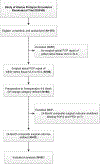Association Between Enlarged Genital Hiatus and Composite Surgical Failure After Vaginal Hysterectomy With Uterosacral Ligament Suspension
- PMID: 36701331
- PMCID: PMC10132998
- DOI: 10.1097/SPV.0000000000001309
Association Between Enlarged Genital Hiatus and Composite Surgical Failure After Vaginal Hysterectomy With Uterosacral Ligament Suspension
Abstract
Importance: The impact of a persistently enlarged genital hiatus (GH) after vaginal hysterectomy with uterosacral ligament suspension on prolapse outcomes is currently unclear.
Objectives: This secondary analysis of the Study of Uterine Prolapse Procedures Randomized trial was conducted among participants who underwent vaginal hysterectomy with uterosacral ligament suspension. We hypothesized that women with a persistently enlarged GH size would have a higher proportion of prolapse recurrence.
Study design: Women who underwent vaginal hysterectomy with uterosacral ligament suspension as part of the Study of Uterine Prolapse Procedures Randomized trial (NCT01802281) were divided into 3 groups based on change in their preoperative to 4- to 6-week postoperative GH measurements: (1) persistently enlarged GH, 2) improved GH, or (3) stably normal GH. Baseline characteristics and 2-year surgical outcomes were compared across groups. A logistic regression model for composite surgical failure controlling for advanced anterior wall prolapse and GH group was fitted.
Results: This secondary analysis included 81 women. The proportion with composite surgical failure was significantly higher among those with a persistently enlarged GH (50%) compared with a stably normal GH (12%) with an unadjusted risk difference of 38% (95% confidence interval, 4%-68%). When adjusted for advanced prolapse in the anterior compartment at baseline, the odds of composite surgical failure was 6 times higher in the persistently enlarged GH group compared with the stably normal group (95% confidence interval, 1.0-37.5; P = 0.06).
Conclusion: A persistently enlarged GH after vaginal hysterectomy with uterosacral ligament suspension for pelvic organ prolapse may be a risk factor for recurrent prolapse.
Copyright © 2022 American Urogynecologic Society. All rights reserved.
Conflict of interest statement
M.S.B. received research support from Hologic, Axonics. K.L.F. received grant support from Valencia Technologies and BlueWind Medical. A.G.V has stock ownership in Ninomed. M.G.G received research grant to RTI as the PFDN DCC from Boston Scientific. The remaining authors have declared they have no conflicts of interest.
References
-
- Jelovsek JE et al., “Effect of uterosacral ligament suspension vs sacrospinous ligament fixation with or without perioperative behavioral therapy for pelvic organ vaginal prolapse on surgical outcomes and prolapse symptoms at 5 years in the OPTIMAL randomized clinical trial,” JAMA - Journal of the American Medical Association, vol. 319, no. 15, pp. 1554–1565, Apr. 2018, doi: 10.1001/jama.2018.2827. - DOI - PMC - PubMed
Publication types
MeSH terms
Associated data
Grants and funding
- U10 HD041261/HD/NICHD NIH HHS/United States
- UG1 HD069013/HD/NICHD NIH HHS/United States
- U10 HD054215/HD/NICHD NIH HHS/United States
- U10 HD054214/HD/NICHD NIH HHS/United States
- UG1 HD069006/HD/NICHD NIH HHS/United States
- U01 HD069031/HD/NICHD NIH HHS/United States
- U10 HD041267/HD/NICHD NIH HHS/United States
- UG1 HD041267/HD/NICHD NIH HHS/United States
- UG1 HD054215/HD/NICHD NIH HHS/United States
- U10 HD069025/HD/NICHD NIH HHS/United States
- UG1 HD069010/HD/NICHD NIH HHS/United States
- U10 HD069013/HD/NICHD NIH HHS/United States
- UG1 HD054214/HD/NICHD NIH HHS/United States
- U10 HD069006/HD/NICHD NIH HHS/United States
- U10 HD069010/HD/NICHD NIH HHS/United States
- UG1 HD041261/HD/NICHD NIH HHS/United States
- U24 HD069031/HD/NICHD NIH HHS/United States
LinkOut - more resources
Full Text Sources
Medical

